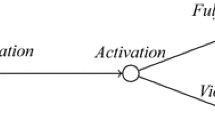Abstract
abstract In previous work, we proposed the prototype environment SNet for the representation and dynamic evaluation of agent-based designs for inter-organizational networks. A key feature of SNet is the automatic translation of extended i* models into the action language ConGolog. An issue we have not yet considered is how to arrive at the foundational and hopefully realistic i* model. Currently there is no support to incorporate information from already existing descriptions of business processes in an enterprise. BPEL is expected to play an important role in the future by enabling interoperability of different partners’ business processes – not only in the web service domain. Once standardized a wide-spread availability of BPEL-based process descriptions can be expected. In this paper we suggest how to map BPEL descriptions into i* descriptions, thus opening the door to generating SNet simulations of business processes from BPEL descriptions.
Access this chapter
Tax calculation will be finalised at checkout
Purchases are for personal use only
Preview
Unable to display preview. Download preview PDF.
Similar content being viewed by others
References
Gans, G., Jarke, M., Kethers, S., Lakemeyer, G.: Continuous requirements management for organization networks: A (dis)trust-based approach. Requirements Engineering Journal, Special Issue RE 2001 8, 4–22 (2003)
Yu, E.: Modelling Strategic Relationships for Process Reengineering. PhD thesis, University of Toronto (1995)
de Giacomo, G., Lespérance, Y., Levesque, H.: ConGolog, a concurrent programming language based on the situation calculus: language and implementation. Artificial Intelligence 121, 109–169 (2000)
Jarke, M., Eherer, S., Gallersdörfer, R., Jeusfeld, M.A., Staudt, M.: ConceptBase - a deductive object base for meta data management. Journal of Intelligent Information Systems, Special Issue 4, 167–192 (1995)
Gans, G., Jarke, M., Lakemeyer, G., Schmitz, D.: Deliberation in a modeling and simulation environment for inter-organizational networks. In: Eder, J., Missikoff, M. (eds.) CAiSE 2003. LNCS, vol. 2681, pp. 242–257. Springer, Heidelberg (2003)
Gans, G., Schmitz, D., Jarke, M., Lakemeyer, G.: SNet reloaded: Roles, monitoring and agent evolution. In: Proc. of AOIS@AAMAS-2004 Workshop (to appear)
Andrews, T., et al.: Business process execution language for web services, IBM, version 1.1, 2nd public draft release (2003), www.ibm.com/developerworks/webservices/library/ws-bpel
Arkin, A.: Business process modeling language 1.0. Technical report, BPMI Consortium (2002), http://www.bpmi.org/
Kavantzas, N., Burdett, D., Ritzinger, G.: Web services choreography description language 1.0. working draft (2004), http://www.w3.org/TR/ws-cdl-10/
Petrie, C., Bussler, C.: Service agents and virtual enterprises: A survey. IEEE Internet Computing, 68–78 (2003)
Liu, L., Yu, E.: Organziation Modeling Environment (OME). WWW, http://www.cs.toronto.edu/km/ome (Accessed 2004/08/18)
Mylopoulos, J., Borgida, A., Jarke, M., Koubarakis, M.: Telos - representing knowledge about information systems. ACM Transactions on Information Systems 8, 325–362 (1990)
McCarthy, J.: Situations, actions and causal laws. Tech. report, Stanford (1963); Reprinted 1968 in Minsky, M.(ed.): Semantic Information Processing, MIT Press
Vidal, J.M., Buhler, P., Stahl, C.: Multiagent systems with workflows. IEEE Internet Computing, 76–82 (2004)
McIlraith, S., Son, T.C.: Adapting Golog for composition of semantic web services. In: Proc. of the 8th Int. Conf. on Knowledge Representation and Reasoning (KR 2002), pp. 482–493 (2002)
Mandell, D.J., McIlraith, S.A.: Adapting BPEL4WS for the semantic web: The bottom-up approach to web service interoperation. In: Proc. of the 2nd Int. Semantic Web Conf., ISWC (2003)
Author information
Authors and Affiliations
Editor information
Editors and Affiliations
Rights and permissions
Copyright information
© 2004 Springer-Verlag Berlin Heidelberg
About this paper
Cite this paper
Schmitz, D., Lakemeyer, G., Gans, G., Jarke, M. (2004). Using BPEL Process Descriptions for Building Up Strategic Models of Inter-organizational Networks. In: Meersman, R., Tari, Z., Corsaro, A. (eds) On the Move to Meaningful Internet Systems 2004: OTM 2004 Workshops. OTM 2004. Lecture Notes in Computer Science, vol 3292. Springer, Berlin, Heidelberg. https://doi.org/10.1007/978-3-540-30470-8_65
Download citation
DOI: https://doi.org/10.1007/978-3-540-30470-8_65
Publisher Name: Springer, Berlin, Heidelberg
Print ISBN: 978-3-540-23664-1
Online ISBN: 978-3-540-30470-8
eBook Packages: Springer Book Archive




